The Labor Force Survey (LFS) is one of the nationwide household surveys undertaken quarterly which provides up-to-date information on the Philippine labor force and its characteristics. This survey gathers data on the demographic and socio- economic characteristics of the population and aims to provide a quantitative framework for the preparation of plans and formulation of policies affecting the labor market.
From the preliminary results of the January 2024 Labor Force Survey (LFS), Central Visayas has 5,764,000 total population of 15 years old and over wherein 60.7 percent were engaged in the Labor Force also known as the Labor Force Participation Rate (Table 1).
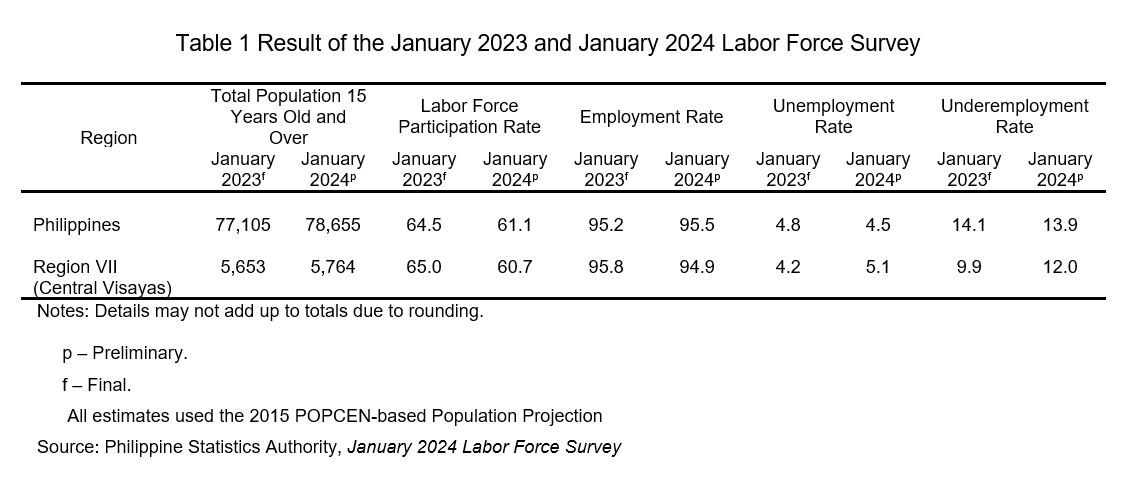
Labor Force Participation Rate is the percentage of the total number of persons in the labor force to the population of 15 years old and over.
The labor force population consists of the employed and the unemployed persons 15 years old and over.
The national employment rate in January 2024 was estimated at 95.5 percent. Among regions, Central Visayas had an employment rate of 94.9 percent which is lower compared with the national estimate (Table 2).


The national unemployment rate in January 2024 was estimated at 4.5 percent. Among regions, Central Visayas had an unemployment rate of 5.1 percent, higher than the national unemployment rate. (Table 3).
By definition, employed persons who express desire to have additional hours of work in their present job, or to have additional job, or to have a new job with longer working hours are considered underemployed.
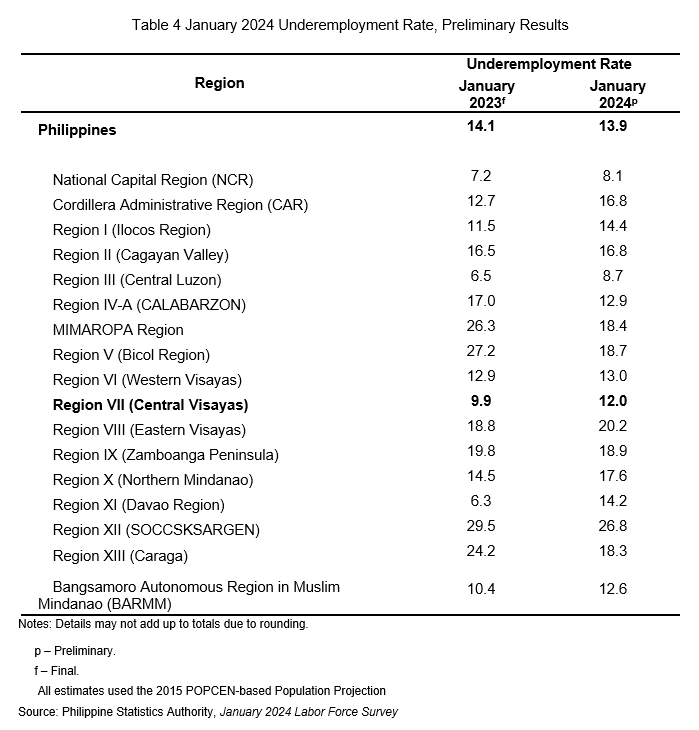
In January 2024, the underemployment rate of Central Visayas was estimated at 12.0 percent. There were fourteen (14) other regions with higher underemployment rates compared to Central Visayas (Table 4).
Underemployed persons who work for less than 40 hours in a week are called visibly underemployed persons.
The January 2024 Employment, Unemployment, and Underemployment Rates were taken from the preliminary result of the January 2024 Labor Force Survey (LFS) conducted by the Philippine Statistics Authority (Table 5).

TECHNICAL NOTES
I. Introduction
a. Background
The stability and growth of a country’s economy hinges on its ability to produce goods and services for both domestic and international use. Labor represents an important factor of production; hence, the improvement of the quality of the labor force and efforts to make it more productive and responsive to growth are necessary for the development of the economy. A clear knowledge and understanding of the size, composition, and other characteristics of the segment of the population is a big step in this direction. A continuing supply of the data on labor force is indispensable to national and local development planning.
The Labor Force Survey (LFS) is a nationwide quarterly survey of households conducted by the Philippine Statistics Authority (PSA) to gather data on the demographic and socio-economic characteristics of the population until 2020. Starting 2021, the LFS was conducted monthly in response to the need for high-frequency data to monitor the impacts of the COVID-19 pandemic.
b. Objectives
The LFS aims to provide a quantitative framework for the preparation of plans and formulation of policies affecting the labor market.
Specifically, the survey is designed to provide statistics on levels and trends of employment, unemployment, and underemployment for the country, as a whole, and for each of the administrative regions.
c. Scope and Coverage
The survey operations for January 2024 LFS ran from 08 to 31 January 2024 and covered 171,197 eligible sample households.
Overseas Filipino Workers are not considered part of the labor force in the Philippines. Hence, in the LFS, data on economic characteristics of household members who are overseas workers are not collected. In the LFS report, they are excluded in the estimation of the size of working population, i.e., population aged 15 years and older, and in the estimation of the labor force.
d. Developments in the LFS
The LFS, as in any survey, adopts recent developments in statistical methodology/processes and in the education system. The revision in the LFS are as follows:

II. Concepts and Definitions
a. Reference Period
The reference period for this survey is the “past week” referring to the past seven days preceding the date of visit of the enumerator or the interviewer.
b. Employment Status Concepts
1. Population 15 years Old and Over
The refers to the number of population 15 years old and over excluding overseas workers. Overseas workers are excluded in the estimation of the size of working population (population aged 15 years and over) since the data on their economic characteristics are not collected because they are not considered part of the labor force in the country.
2. In the Labor Force or Economically Active Population
This refers to persons 15 years old and over who are either employed or unemployed in accordance with the definitions described below.
3. Employed
Employed persons include all those who, during the reference period are 15 years old and over as of their last birthday, and are reported either:
a. At work, i.e., those who do any work even for one hour during the reference period for pay or profit, or work without pay on the farm or business enterprise operated by a member of the same household related by blood, marriage, or adoption; or
b. With a job but not at work, i.e., those who have a job or business but are not at work because of temporary illness or injury, vacation, or other reasons. Likewise, persons who expect to report for work or to start the operations of a farm or business enterprise within two weeks from the date of the enumerator’s visit are considered employed.
4. Underemployed
Underemployed persons include all employed persons who express the desire to have additional hours of work in their present job, or an additional job, or to have a new job with longer working hours. Visibly underemployed persons are those who work for less than 40 hours during the reference period and want additional hours of work.
5. Unemployed
Starting April 2005, the new unemployment definition was adopted per NSCB Resolution Number 15 dated October 20, 2004. As indicated in the said resolution:
Unemployed persons include all those who, during the reference period, are 15 years old and over as of their last birthday, and reported as persons:
a) Without work, i.e., had no job or business during the reference period;
b) Currently available for work, i.e., were available and willing to take up work in paid employment or self-employment during the reference period, and/or would be available and willing to take up work in paid employment or self-employment within two weeks after the interview date; and
c) Seeking work, i.e., had taken specific steps to look for a job or establish a business during the reference period, or
Not seeking work due to the following reasons: (1) fatigued or believed no work available, i.e., discouraged workers; (2) awaiting results of previous job application; (3) temporary illness or disability; (4) bad weather; and/or (5) waiting for rehire or job recall.
6. Persons Not in the Labor Force
Persons 15 years old and over who are neither employed nor unemployed according to the definitions mentioned. Those not in the labor force are persons who are not looking for work because of reasons such as housekeeping, schooling and permanent disability. Examples are housewives, students, persons with disability, or retired persons.
III. Sampling Design and Estimation Methodology
The January 2024 LFS utilized the 2023 Geo-enabled Master Sample (GeoMS) design from which 16 replicates were drawn that includes 172,800 secondary sampling units (SSUs) or sample housing.
The 2023 Geo-enabled Master Sample (GeoMS) design for household-based surveys is a two-stage cluster sampling design with barangays or enumeration areas (EAs) or groups of nearby barangays or EAs as the primary sampling unit (PSU), and housing units serving as the SSU within the PSUs. In the first stage, PSUs are systematically selected from the Master Sample PSU frame of each sampling domain with equal probability. During the second stage of selection, housing units are drawn systematically for each sample PSU.
Generally, all households within the sample housing unit are also considered as sample households. However, for housing units with more than three households, a maximum of three sample households were randomly selected.
Sampling Frame
The 2023 Geo-enabled MS sampling frame is constructed based on the results of the 2020 Census of Population and Housing. The EA Reference File (EARF) of the 2020 Census of Population is used as the PSU frame while the 2020 list of households for each of the PSUs is used as the SSU frame.
Sampling Domain
To provide subnational or provincial level statistics with precise estimates the 2023 GeoMS has 118 sampling domains. Listed as follows: 82 provinces (including Maguindanao del Norte and Maguindanao del Sur); 33 highly urbanized cities (including 16 cities in the National Capital Region); and 3 other urban areas (Pateros, Isabela City, and Cotabato City).
Primary Sampling Units
In the 2023 GeoMS Design, each sampling domain (i.e., province/HUC) is divided into exhaustive and non-overlapping area segments known as Primary Sampling Units (PSUs) with about 100 to 300 households. A PSU can be any of the following:
a) A single enumeration area (EA) barangay; or
b) Two or more adjacent small EAs within the same barangay; or
c) Two or more adjacent small barangays of the same city/municipality; or
d) Portion or an EA of a multi-EA barangay.
Out of the 42,046 barangays in the Philippines, 127,028 PSUs were formed. A significant number of these PSUs, or about 15 percent of the total were formed in Region IV-A. CAR has the fewest PSUs formed, making up about 2 percent of the total.
Moreover, identified least accessible areas (LAAS), excluding those that passed the 3rd criterion, will be included in the Philippine Statistics Authority (PSA) survey operations at least once a year.
LAA can be a barangay (LAB), an enumeration area (LAEA), or a purok/sitio/segment (LAPSS) of an EA/barangay that fits into one of the following criteria: (1) if the frequency of the trip is only once or less than once a week, (2) cost of a one-way trip is more than Php1,500, and (3) more than eight (8) hours of walk from the last drop-off point of the transportation facility.
That is, in case of LAAs, a separate LAA PSU group will be formed and appended to the original PSU Frame. This will be selected based on the same sampling interval as an oversample of PSUs. The selection probability of LAA PSUs would be computed similarly to that of all regular PSUs.
Replicates
From the ordered list of PSUs, all possible systematic samples of 6 PSUs are drawn to form a replicate for most of the province domain i.e., 76 out of 82 provinces while all possible systematic samples of 8 PSUs are drawn to form a replicate for most of the HUCs, that is, 31 of 33 HUCs.
Three (3) PSUs are drawn to form a replicate for small provinces domains, namely, Batanes, Guimaras, Siquijor, Camiguin, Apayao, and Dinagat Islands, and three (3) to five (5) PSUs per replicate are allocated for small HUCs such as San Juan City and Lucena City and for special areas such as Pateros, City of Isabela, and Cotabato City.
Sample Allocation Scheme
The total number of sample SSUs are allotted proportionately to the measure of size of the PSU. Thus, a PSU with lesser number of housing units/households would have lesser number of sampled SSUs than those PSUs with larger number of housing units/households. On the average, a total of 12 sample Housing Units are allotted for each sample PSUs in Highly Urbanized City domain while 16 sample housing units/households are allotted for every PSUs in province domain.
Base Weight Computation
The base weight is computed as the inverse of selection probability

For housing units with at most 3 households the base weight is computed as

For housing units with more than 3 households the base weight is computed as

Base Weight Adjustment
The base weight adjusted for unit non-response and was further calibrated to conform to the known or projected population count. The January 2024 projected population count was used for the January 2024 LFS.
For unit non-response adjustment (within domain p), the adjustment was computed as:

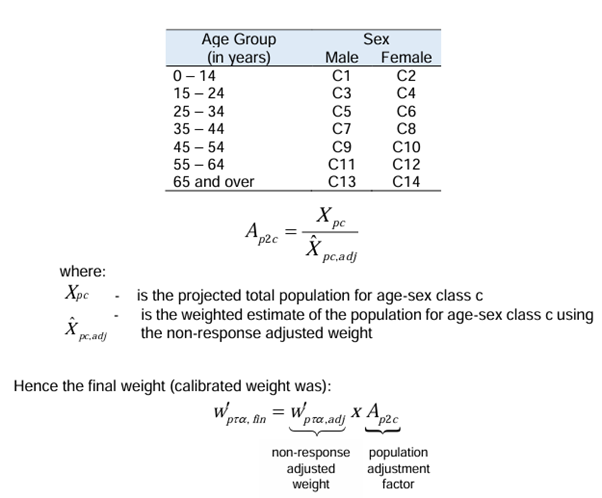
Estimation of Totals
• Generally, the estimate for the weighted total for a sampling domain (province/HUC) considering the number of sample replicates was derived using:

• For each of the sampling domain which considered 16 sample, the estimate for the weighted total was computed as the value of the sample household for variable Y multiplied by its corresponding weight using this formula:

• For the Province/HUC
The estimate for the weighted total for the province/HUC was derived as the average of the estimates for the 16 replicates:

• For the Region
The estimate for the weighted total for the region was derived as the sum of its weighted provinces/HUCs domain totals:

• For the entire country
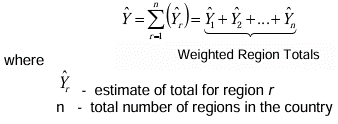
Estimation of Rates and Proportions
Rates will be computed as for example employment rate:

Estimation of Sampling Error
Sampling error is usually measured in terms of the standard error for a particular statistic (mean, percentage, etc.), which is the square root of the variance.
If the sample had been selected as a simple random sample, it would have been possible to use straightforward formulas for calculating sampling errors. However, the LFS is the result of a multi-stage design, and it was necessary to use more complex formulas.
Sampling errors are computed using statistical programs. These statistical programs use the Taylor linearization method to estimate variances for survey estimates that are means, proportions, or ratios.
The Taylor linearization method treats any percentage or average as a ratio estimate, r=y/x, where y represents the total sample value for variable y, and x represents the total number of cases in the group or subgroup under consideration. The variance of r is computed using the formula given below, with the standard error being the square root of the variance:
Its formula is given as follows:
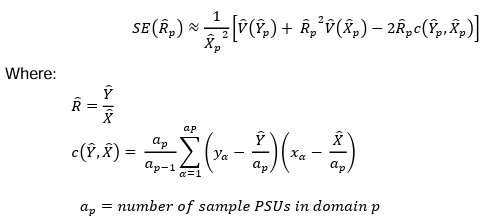
In the LFS, the 118 province/HUC domains are also treated as natural stratification while the primary sampling units (PSUs) are treated as clusters.
Data Checking, Coding and Filtering Prior to Estimation of Proportions
Enumeration is a highly complex operation, and it may happen that reported/encoded entries during the data collection may have some omissions, and implausible/inconsistent entries. Editing is a process meant to correct these errors.
During the interview, embedded editing was activated, and errors/inconsistent entries were detected by the program. Editing was also done using Computer Aided Field Editing (CAFÉ) program after every interviewed household to ensure completeness and consistency of encoded entries. For monitoring of the status of data collection, LFS raw data from the tablet is uploaded to the PSA Central Office server as soon as the interview of a household/EA was completed.
Review and verification of the PSOC and PSIC codes and invalid values for LFS data items were done in the provincial office using the LFS Information System (LFS IS). Further processing in the regional office such as ID validation, and completeness check, edit and matching of LFS sample households with the original List from Master Sample (MS) Form 6 were done to ensure that the number of households listed was fully covered.
Preliminary and final tabulations of data were done at the PSA Central Office.
IV. Dissemination of Results
The January 2024 LFS preliminary results press release, and the statistical tables are publicly available at the PSA website www.psa.gov.ph.
Approved by:
(SGD.)
ARIEL E. FLORENDO
Regional Director

